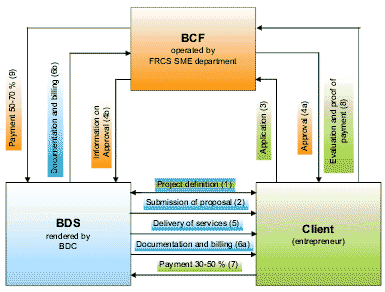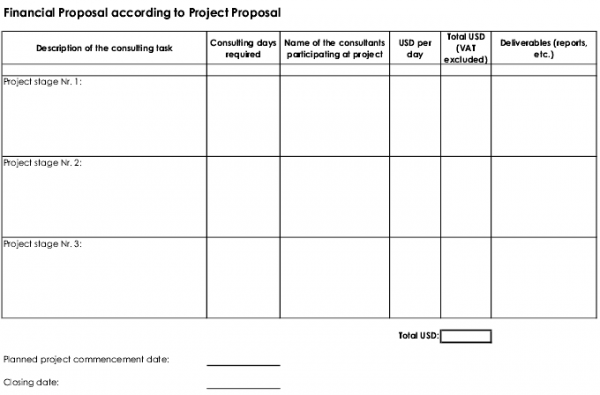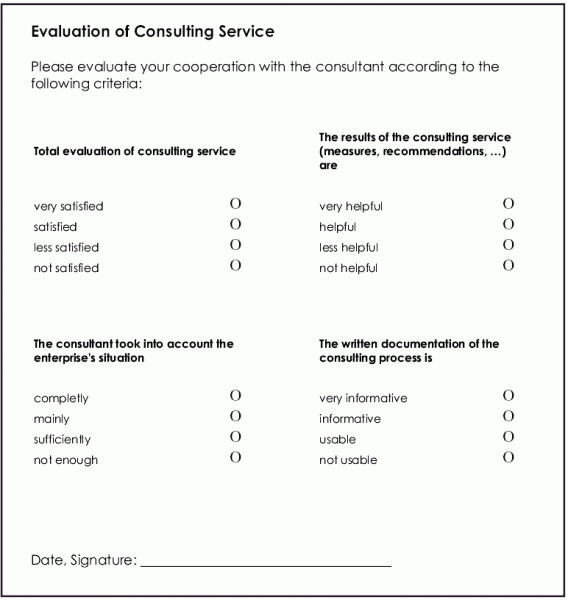Business Consultancy Fund - Principles and General Procedures
|
|
The success of a Business Consultancy Fund is dependent upon a number of key variables, including:
|
|
|
The primary steps to establish a Business Consultancy Fund are: A. Introduce the idea of the BCF to Business Development Centres and other stakeholders. This can be accomplished at a kick-off meeting with local entrepreneurs, financing institutions, development organisations and other identified stakeholders. B. Establish Fund guidelines that define (i) the target group; (ii) who is eligible to apply for business consultancy services; (iii) the type and extent of consulting services financed by the fund; and (iv) the prices and limits of the consulting services provided. As a general principle, applicants for consulting services should be required to make a financial contribution towards the cost of the consulting services. This ensures that requested services are responding to a genuine perceived need. C. Develop an Operational Manual that sets forth the roles and relationships between the Fund, the BDC, and the MSE client. The Operational Manual should clearly define the application procedures, criteria for the acceptance of proposals, and documentation and payment procedures. The flowchart depicted in figures 1 and 2 presents schematic mechanics of a BCF operations, including the elements which should be covered in the proposed operational manual. D. Establish administrative and decision making structures. To operate smoothly, the Business Consultancy Fund needs an administrative institution supported by a decision making body (DMB). The responsibility for application selection should be allocated to the DMB. Members of the DMB should include representatives of the funding organisation(s), service providers, and individuals who are respected economic experts such as managers and/or owners of SMEs, micro finance institutions, commercial banks, and personnel from governmental units with MSE oversight responsibilities. E. Inform the target community of the Business Consultancy Fund and its conditions. Before the Fund can begin operations, information about it must be disseminated to the intended target group through mechanisms such as brochures or mass media outreach (newspaper, radio, television). The information should include how entrepreneurs can request consulting services, the selection criteria, and conditions for financing and payment. F. Train BDC staff on the Fund’s application, documentation and payment procedures, and train the Fund’s decision making body on the procedures for the approval of proposals. G. Contract the business service provider to provide services and apply the procedures. After application approval, a contract between BCF administration and the business service provider will be concluded which states the project approved, amount and use of local grant and its provision, rights and responsibilities of the parties according to project implementation rules. After the contract is signed, the grant is provided according to the operational manual. H. Monitor the Fund implementation and revise the regulations and procedures if necessary. The BCF-administration should control use of the Fund and check the quantity and quality of services performed. It should assess the financing requests and raise additional funds as necessary. DMB members should be authorised to make principle adjustment to the conditions governing the Fund when necessary to account for unforeseen changes. I. Evaluate the impact of the Business Consultancy Fund. Periodic evaluations should take place every three to six months, as determined in advance by the DMB. An external party should report on the services provided and determine the extent to which the Fund delivered the intended direct and indirect benefits to the target groups. |
 |
The step-by-step process required for developing a BCF has been graphically depicted in figure 1. The approach to be followed is as follows: (1) Project definition: The BDC defines the project together with the client. (2) Submission of proposal: After the project has been defined, the Business Development Centre service provider submits a project proposal and a financial proposal to the client. The project proposal identifies the problem confronted by the enterprise and defines the consultancy services that would address the problem. Figure 2 is a sample project proposal form. Figure 1: The Concept of a Business Consultancy Fund
Figure 2: Suggested “Project proposal” form Under the project proposal, the BDC develops the financial proposal for the provision of services. The financial proposal describes the project stages, planned consulting work in each stage, and the costs of the services. Figure 3 is a sample Financial Project Proposal form.
Establishing specific criteria for the acceptance of applications is an important step in ensuring that the Fund will meet the objectives of its donors. Depending on the objectives established for the Fund, two criteria are of particular importance:
Figure 3: Suggested “Financial Project Proposal” form Other application selection criteria could include:
(4b) Contracting: At the same time the proposal is approved, the BCF administration informs the BDC about the consulting assignment and contracts with the BDC to provide the consulting services according to the approved project proposal. |
 |
(8) Evaluation and Proof of Payment: The client submits to the BCF-administration an evaluation of the consulting services and proof of payment. Figure 4 is a sample Evaluation Sheet.
|




